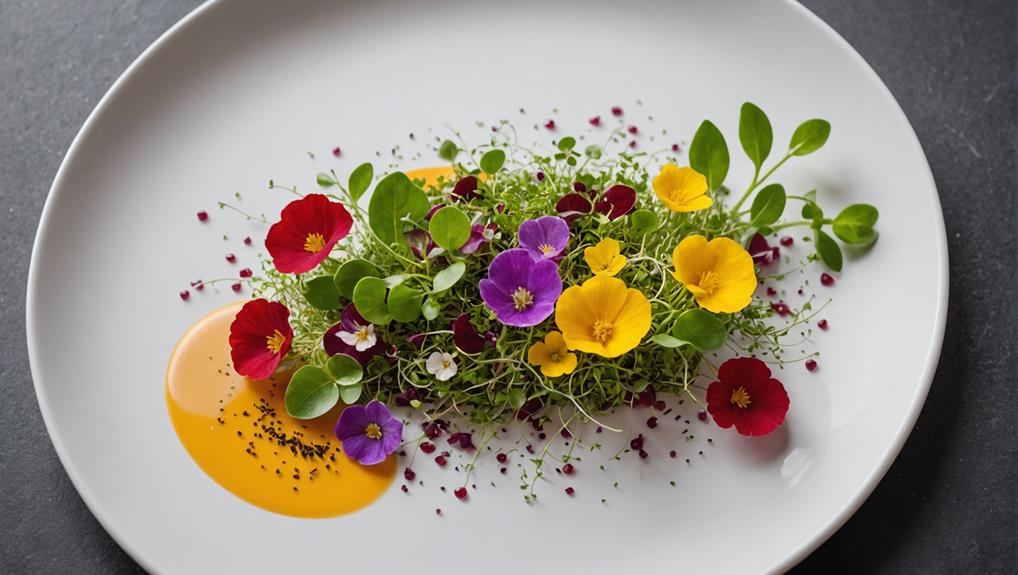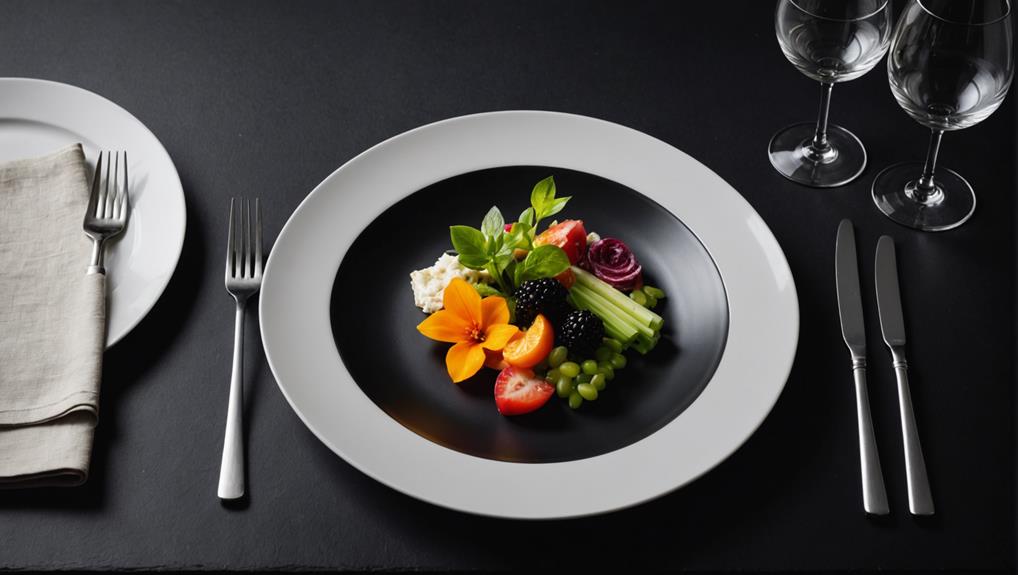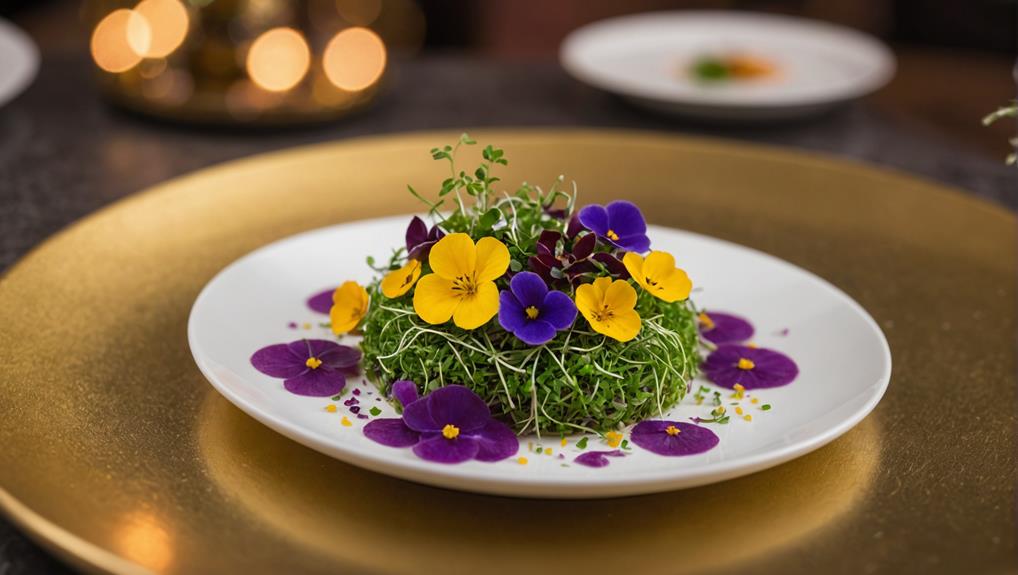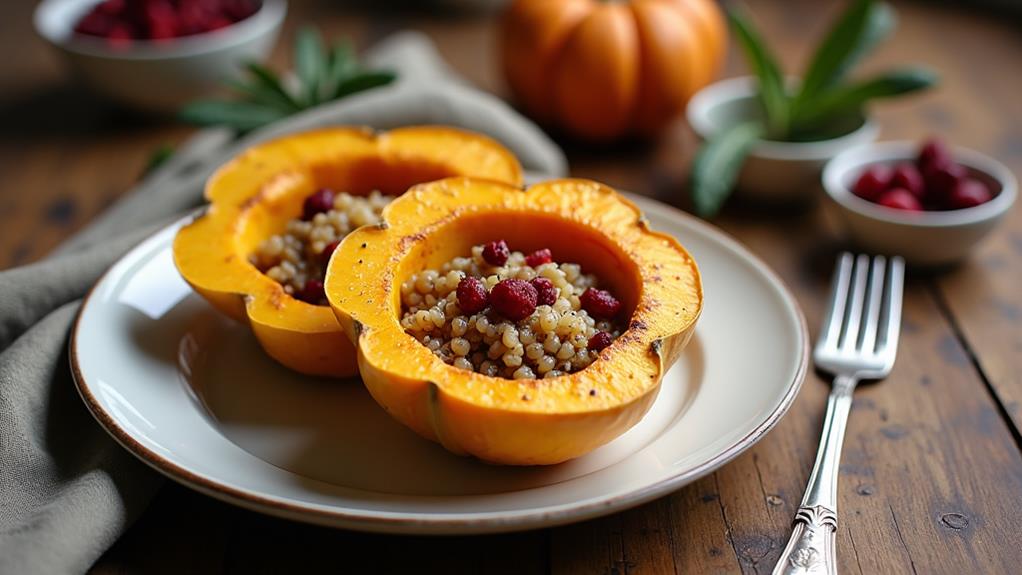To elevate your culinary artistry, focus on both visual and flavor elements. Select plates that complement your dish, considering material, size, and shape. Master composition techniques like asymmetrical plating and effective use of negative space. Experiment with contrasting textures, colors, and heights to create visually stunning presentations. Incorporate innovative garnishes, such as edible flowers or microgreens, to enhance both aesthetics and taste. Use high-quality tools and seasonal ingredients to perfect your creations. Don't forget to engage diners with interactive elements or tableside preparations. By mastering these aspects of gourmet gastronomy, you'll transform ordinary meals into extraordinary sensory experiences. Exploring further will unlock even more secrets to culinary excellence.
The Art of Plate Selection
In the world of gourmet gastronomy, plate selection is far more than just choosing a vessel for food. It's an art form that can elevate your culinary creations to new heights. When you're aiming to innovate, consider the impact of plate material on your dish's presentation.
Porcelain, stoneware, and glass each offer unique qualities that can enhance the visual appeal of your food.
Plate size and shape play a crucial role in your presentation strategy. Larger plates create a sense of abundance, while smaller, uniquely shaped ones highlight minimalism and elegance.
Don't shy away from asymmetrical designs; they can guide the eye across your dish, allowing for creative food arrangements.
To add depth to your presentation, explore plates with textured surfaces. These create an engaging contrast with smooth food elements, adding another layer of visual interest.
When it comes to color, be bold. Dark or vibrant hues can make colorful dishes pop, enhancing overall visual appeal.
Mastering Color and Texture Harmony
A symphony of colors and textures awaits you in the realm of gourmet gastronomy. To master this culinary orchestra, you'll need to embrace the art of color contrast and texture balance. Start by selecting ingredients with bold, vibrant hues that not only please the eye but also stimulate the appetite.
For example, consider incorporating the earthy flavor of roasted beets alongside creamy goat cheese to create a visually striking and delicious dish. Pair crispy elements with creamy sauces to create a textural dance on the palate, enhancing the overall dining experience.
When it comes to plating techniques, think outside the box. Embrace asymmetrical arrangements, positioning main components off-center to guide the diner's eye and create visual intrigue.
Elevate your dishes further by incorporating edible flowers and microgreens, adding sophistication and a pop of color to your creations.
Don't overlook the power of ingredient pairing. Combine tender proteins with crunchy vegetables to create a sensory masterpiece that delights both the eyes and taste buds.
Essential Tools for Culinary Artistry

Now that you've mastered the visual aspects of gourmet gastronomy, it's time to equip your kitchen with the right tools for culinary artistry. To elevate your culinary skills to new heights, investing in essential tools is crucial.
Start with a high-quality chef's knife, which will ensure safe and precise cuts, enhancing both food preparation and presentation. A sturdy stainless steel skillet is indispensable for even heat distribution and excellent searing, key to developing complex flavors in your dishes. Incorporating seasonal ingredients like those found in Harvest Vegetable Soup can transform your creations.
For slow-cooking techniques, a versatile Dutch oven is your best friend, delivering consistent results for tender meats and flavorful stews.
Don't overlook the importance of a non-stick sauté pan, which simplifies cooking and cleanup while perfectly cooking proteins and vegetables.
Composition Principles in Food Plating
Mastering the art of food plating is essential for elevating your culinary creations from mere meals to visual masterpieces. To achieve this, you'll need to understand and apply key composition principles that will transform your visual presentation.
Start by embracing asymmetrical plating, which creates harmony by positioning main elements off-center, guiding the diner's eye across the plate. Incorporate contrasting textures, shapes, and colors to add impact and make your dishes more visually exciting; for example, consider how the colors and textures of Caprese ingredients can enhance your presentation.
Don't overlook the power of edible flowers and microgreens. These not only enhance the aesthetic but also introduce new flavors and textures. Use vibrant sauces artfully drizzled or dotted around the plate to turn simple dishes into stunning works of art.
Remember, strategic use of negative space is crucial for a refined look. It emphasizes your dish's main components while preventing overcrowding.
Innovative Garnishing Techniques

Building on the principles of composition, innovative garnishing techniques take your culinary presentation to the next level. You'll transform dishes by incorporating edible flowers, microgreens, and vibrant sauces that enhance both visual appeal and flavor profiles.
Don't hesitate to experiment with flavored oils or foams, adding unexpected taste experiences while elevating the overall presentation.
Consider using dehydrated ingredients like fruit powders or vegetable chips to introduce concentrated flavors and textures that complement your main components. Asymmetrical plating can create visual interest, guiding diners' eyes and making dishes more inviting. Place garnishes off-center to achieve this effect.
To further enhance the dining experience, try using unconventional serving vessels such as slate or wooden boards. These unique platforms will highlight your creative garnishing approach and set your dishes apart.
Balancing Flavors Through Visual Appeal
The art of balancing flavors through visual appeal combines culinary skill with aesthetic sensibility. When you're crafting a dish, remember that studies show visually appealing plates significantly influence taste perception.
To elevate your culinary creations, incorporate vibrant ingredients like fresh herbs, colorful vegetables, and bold sauces. These elements not only enhance the dish's appearance but also contribute to its flavor complexity.
Experiment with asymmetrical plating techniques, positioning main elements off-center to guide the diner's eye and create harmony. This approach emphasizes the balance of flavors within the dish.
Utilize garnishes such as edible flowers and microgreens to introduce subtle flavor notes that complement the main components. These additions enrich the overall tasting experience while enhancing visual appeal.
To further engage your diners, employ innovative presentation methods. Try artfully drizzling sauces or using unconventional serving surfaces to make your dishes visually striking.
These techniques highlight the balance of flavors within each element. By mastering the art of balancing flavors through visual appeal, you'll create a multisensory dining experience that delights both the palate and the eye.
Elevating Dishes With Negative Space

Chefs can take their culinary presentations to new heights by embracing the power of negative space. This innovative approach to plating transforms a dish from mere sustenance into a visually stunning culinary experience. By intentionally leaving areas of the plate empty, you'll guide your diners' focus to the main components, creating a sense of balance and elegance that's crucial for gourmet presentation.
When you incorporate negative space effectively, you're not just arranging food; you're telling a story. The contrast between filled and empty spaces draws attention to textures and colors, emphasizing the freshness and quality of your ingredients. This technique allows each element to breathe and stand out, making the dining experience more engaging and thought-provoking for your guests.
To master the art of negative space, consider the overall composition of your dish. Use empty areas strategically to create visual pathways that lead the eye to key components.
Experiment with different plate sizes and shapes to find the perfect canvas for your culinary creations. Remember, the goal is to elevate your dishes from delicious meals to unforgettable works of art that delight both the eyes and the palate.
Perfecting the Final Presentation Touch
Mastery of the final presentation touch elevates a dish from excellent to extraordinary. As you strive for visually stunning food presentation, consider employing asymmetrical plating techniques. By positioning main elements off-center, you'll create visual harmony and guide diners' eyes through the dish's components.
Incorporate vibrant sauces through artful drizzles or dots to enhance appeal and add dynamism to your creation. Don't shy away from unconventional serving surfaces like slate or wood. These unique backdrops can complement your dish's aesthetics and elevate the overall dining experience.
To further enhance visual appeal and introduce subtle flavors, consider using edible flowers and microgreens as unique ingredients. These delicate additions not only please the eye but also provide interesting textures.
Lastly, engage your diners through interactive elements. Tableside preparations or assembly stations create memorable experiences that transcend visual presentation. By involving guests in the final touches, you're not just serving a meal; you're crafting an immersive culinary journey.
Frequently Asked Questions
What Is Gastronomy and Culinary Arts?
You're exploring food culture through gastronomy and culinary arts. They're your gateway to sensory experiences and flavor science. You'll master techniques, innovate presentations, and push boundaries in cooking, transforming meals into artistic expressions that excite and inspire.
What Is the Difference Between Gastronomy and Culinary Tourism?
Did you know that 53% of travelers consider food experiences crucial when choosing destinations? While gastronomy focuses on culinary artistry, culinary tourism is your passport to global food culture exploration, offering hands-on gastronomic experiences and innovative culinary adventures worldwide.
What Is the Difference Between Gastronomy and Cooking?
While you're cooking, you're simply preparing food. In gastronomy, you're exploring gourmet ingredients, mastering advanced culinary techniques, and analyzing complex flavor profiles. It's an innovative approach that elevates your culinary experience beyond just making meals.
What Does Gastronomy Include?
Picture a chef using liquid nitrogen to create a mango foam. Gastronomy includes molecular gastronomy, sustainable ingredients, and innovative flavor pairings. You'll explore culinary techniques, food history, and presentation aesthetics to craft exceptional dining experiences that push culinary boundaries.
Final Thoughts
As you've explored the art of gourmet gastronomy, you've learned to transform ordinary dishes into extraordinary culinary masterpieces. By mastering plate selection, color harmony, and innovative garnishing, you're now equipped to elevate your cooking to new heights. Consider the case of Chef Marie, who revitalized her struggling bistro by applying these principles, turning simple local ingredients into visually stunning creations that drew critical acclaim. Remember, in culinary artistry, your plate is your canvas, and every element contributes to the final, delectable masterpiece.













